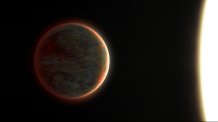
Artist's impression of the exoplanet WASP-121 b. Credit: Patricia Klein and MPIA
Hubble detects exotic water cycle and metal clouds in a hot Jupiter exoplanet atmosphere
Scientists have explored the nightside hemisphere of an enormous planet, far outside our solar system for the first time – revealing metal clouds and rain made of liquid gems.
An international team of researchers, including Professor Nathan Mayne from the University of Exeter, made the new discovery about the fascinating atmosphere of the exoplanet WASP-121b with NASA’s Hubble Space Telescope.
WASP-121b, located approximately 900 light years from Earth, is a gas giant exoplanet commonly referred to as a ‘hot Jupiter’, although with a greater mass and particularly radius than that of our own Jupiter, meaning it is much `puffier’! This exoplanet orbits its host star every 1.3 days, and is around the closest distance it could be before the star's gravity would start ripping it apart.
This close proximity also means that the top of the atmosphere is heated to a blazing hot 2,500 degrees Celsius – the temperature at which iron exists in gas rather than solid form.
For the new study, researchers led by Thomas Mikal-Evans from the Max Planck Institute for Astronomy made the first detailed measurement of the exoplanet’s atmospheric nightside conditions.
By including previous measurements from the dayside hemisphere, they determined how water changes physical states when moving between the hemispheres.
The study revealed a fascinating insight into the conditions within the nightside hemisphere. While airborne metals and minerals evaporate on the hot dayside, the cooler night side features metal clouds and rain made of liquid gems.
The researchers believe this new discovery provides a giant leap in deciphering the global cycles of matter and energy in the atmospheres of exoplanets.
The study is published in Nature Astronomy on Monday, February 21st 2022.
Professor Nathan Mayne, co-author of the study said: “Studies like Tom has led here show the real power of combing cutting-edge observations with state-of-the-art modelling. Facilities like the HST and now the JWST, combined with the knowledge and tools often developed to understand our own planet’s atmosphere are combining to teach us about these fascinating worlds.
“It is incredibly exciting to think what we will learn in the near future about the range of planets our galaxy is home to, and how this can feed back into a better understanding of our own changing world.”
On Earth, water constantly changes its physical state. Solid ice melts into liquid water, which evaporates to gas and then condenses into droplets to form clouds.
The cycle closes when those droplets grow to raindrops that eventually fall down to fill rivers and oceans. However, these new Hubble data revealed a water cycle on WASP-121 b that behaves completely differently.
On the side of the planet facing the central star, the upper atmosphere becomes as hot as about 3000 degrees Celsius. At such temperatures, the water begins to glow, and many of the molecules even break down into their atomic components.
The Hubble data also reveal that the temperature drops by approximately 1500 degrees Celsius on the nightside hemisphere. This extreme temperature difference between the two hemispheres gives rise to strong winds that sweep around the entire planet from west to east, dragging the disrupted water molecules along.
The lower temperatures allow the hydrogen and oxygen atoms to recombine, forming water vapour again before being blown back around to the dayside and the cycle repeats. Temperatures never drop low enough for water clouds to form throughout the cycle, let alone rain.
Instead of water, clouds on WASP-121 b mainly consist of metals such as iron, magnesium, chromium and vanadium. Previous observations have revealed the spectral signals of these metals as gases on the hot dayside.
These new Hubble data indicate that temperatures drop low enough for the metals to condense into clouds on the nightside. The same eastward flowing winds that carry the water vapour across the nightside would also blow these metal clouds back around to the dayside, where they again evaporate.
Strangely, aluminium and titanium were not among the gases detected in the atmosphere of WASP-121 b. A likely explanation for this is that these metals have condensed and rained down into deeper layers of the atmosphere, not accessible to observations.
This rain would be unlike any known in the Solar System. For instance, aluminium condenses with oxygen to form the compound corundum. With impurities of chromium, iron, titanium or vanadium, we know it as ruby or sapphire. Liquid gems could therefore be raining on the nightside hemisphere of WASP-121 b.
“Despite the discovery of thousands of exoplanets, we’ve only been able to study the atmospheres of a small fraction due to the challenging nature of the observations,” Mikal-Evans points out. “So far, most of these measurements have provided limited information, such as basic details on the chemical composition or average temperature in specific subregions of the atmosphere.”
“Diurnal variations in the stratosphere of the ultrahot giant exoplanet WASP-121b” is published in Nature Astronomy.
Date: 21 February 2022
